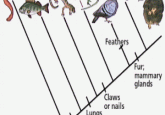A new fountain of youth

The “fountain of youth” model provides an alternative explanation for sex-chromosome evolution.

The X chromosome contains many more genes than the Y chromosome, which is relatively bare and often degenerates. The canonical model for sex-chromosome evolution suggests that mutations beneficial to males arise close to the sex locus on the Y chromosome. This ultimately halts XY recombination, promoting Y chromosome degeneration, as seen in mammals and birds. However, this is not the case for all organisms.
Nicolas Perrin at the University of Laussane studies the frog species, R. temporaria. The sex chromosomes in amphibians, fish, and some reptiles do not always show these same signs of decay. To explain this Perrin proposed an alternative model of sex chromosome evolution in 2009, aptly named the “fountain of youth.” This theory depends on the sex reversal that occurs in these animals when changes in temperature induce sex reversal regardless of genetic sex determination. In organisms such as R. temporaria, rare but spontaneous sex reversal can also occur. Perrin’s theory states that in such cases, the male phenotype actually promotes X and Y chromosome recombination, not the XY genotype. So in an XY female, the X and Y can recombine and prevent Y chromosome degradation.
“We published this idea a few years ago, and of course we were always hoping to find field evidence for this,” explained Perrin. His team’s latest paper in Molecular Biology and Evolution presents the first data to support this hypothesis.
In this study, the scientists collected 314 adult frogs from Meitreile, a small breeding pond in the Western Swiss Alps. Of this sample, they brought 15 mating pairs back to outdoor facilities at Laussane. Among the 54 female frogs they collected, there was 1 XY female. Perrin’s team used 16 genetic markers to calculate the sex-specific recombination rates in the 15 mating adults and their 600 tadpoles.
The resulting consensus linkage maps showed that sex chromosomes in adult females were approximately 75 times longer than in males. This correlated with previous studies in which females showed more genome-wide recombination. Regardless of their sex genotype, males exhibited reduced recombination, as confirmed by a statistical test comparing adult chromosome mapping data to phenotypic or genotypic sex. Although there was only one XY female in the study, she did also exhibit an increase in recombination. Genetic analysis of the 600 offspring further confirmed the scientists’ hypothesis that phenotypic sex had a greater influence on recombination crossover events.
Despite going against the canonical mechanism, first author Nicolas Rodrigues thinks other researchers will be receptive to this model. “I think it is becoming more and more accepted that this old model is maybe not explaining all of the evolutional hallmarks of these sex chromosomes, and these sex antagonistic genes are not as important as we thought once. I think people are not completely against this,” he said.
Moving forward, Perrin and his team have several follow-up projects underway. They plan to test the survival fitness of XY males versus XX males. Preliminary studies already showed that this alteration may affect the early development of reproductive organs.





